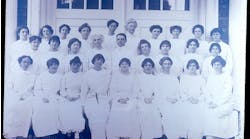Chris Miller
This is the last in a series of articles discussing the five main pathways by which microbes are spread in a dental office:
(1) - Patient to dental team
(2) - Dental team to patient
(3) - Patient to patient
(4) - Office to community
(5) - Community to office
In this article, we`ll discuss how microbes in the community end up in the office.
Water as a source of contaminants
One obvious route by which microbes enter the office from the community is through the water supply. Municipal waters that are deemed safe to drink are not sterile or even free of bacteria, but are essentially free of pathogens. The Environmental Protection Agency (EPA) microbiological standard for safe drinking water is the absence of coliforms. Coliforms are a group of bacteria similar to the bacterium Escherichia Coli (E.Coli) present in our intestinal tract.
The presence of coliforms in water suggests that the water has been contaminated with feces, and water contaminated with feces may contain serious pathogens. Tap water that meets the EPA standard of no coliforms contains a normal flora of other bacteria that commonly exit in water and that usually are nonpathogenic. These other bacteria sometimes are just referred to as heterotrophic bacteria.
However, under rare circumstances these other waterborne microbes could serve as opportunistic pathogens causing harmful infections in compromised persons. Examples of bacteria in water that may be opportunistic pathogens are Pseudomonas aeruginosa and Legionella pneumophila. Besides having a normal flora, water also contains a low level of nutrients to which the waterborne bacteria have become accustomed.
The normal water bacteria that enter a dental office usually are present at very low levels (e.g., 15 colony-forming units [CFU] per milliliter [mL]). However, these bacteria are conditioned to attach to and accumulate on surfaces, especially small-bore waterlines found in the dental units. Thus, as bacteria enter the dental-unit waterlines, they attach to the surfaces and begin to multiply. Cell multiplication can occur because the incoming water continually brings in not only new bacteria, but also fresh nutrients. The mass of bacteria that coats the inside of the waterlines is referred to as a biofilm, and this biofilm can develop in clean dental-unit waterlines within weeks to a few months. Another example of a biofilm is dental plaque.
As dental waterline biofilm develops and matures, it releases bacteria into the water. So water passing over this biofilm can become heavily contaminated with bacteria. The number of bacteria in dental-unit water varies greatly, but can be quite high (for a review see: Miller, CH. Microbes in dental-unit water. CDA Journal 1996; 48 {No 1}: 47-52). One specific example is a study showing an average of about 72,000 CFU/mL of water and a maximum of 550,000 CFU/mL from dental-office-handpiece waterlines. The counts from most faucet water from the same offices were zero (Williams, JF et al. Microbial contamination of dental-unit waterlines: prevalence, intensity and microbiological characteristics. J Amer Dent Assoc 1993; 124: 59-65).
While there is no known widespread public-health problems arising from dental-unit water, infection-control reasoning indicates that water used in the direct treatment of dental patients should at least be drinking-water quality. The ADA is promoting the improvement of dental-water quality and has charged industry and the research community to improve the design of dental equipment. The ADA target: By the year 2000, water delivered to patients during nonsurgical dental procedures consistently contains no more than 200 colony-forming-units of aerobic mesophilic heterotrophic bacteria at any point in time in the unfiltered output of the dental unit (ADA, ADA statement on dental-unit waterlines, J Amer Dent Assoc 1996; 127:185-86).
There are several approaches being considered to improve the microbiological quality of dental-treatment water, more than one of which may be used simultaneously. These are:
- Use the dental-unit water-delivery system, but improve the quality of the incoming water (e.g., chemically or physically treat the municipal water; disconnect from municipal water and use other water in an independent water reservoir)
- Use the dental-unit waterlines, but control biofilm formation (e.g., chemically treat the waterlines with agents that will remove biofilm and/or be antimicrobial; air-purge the waterlines)
- Use a filter to remove microbes and their components from water as it leaves the dental unit (e.g., a microbial filter)
- Use a water-delivery system other than the dental unit (e.g., a sterile water-delivery system; an independent water- delivery system with sterilizable waterlines)
Other sources of contamination
In addition to incoming water, anything else that comes into the dental office from the community likely is contaminated with microbes (e.g., dust, patient`s clothing, and delivered packages). This certainly is not unique for a dental office. Air, dust, etc., enters our homes and all other facilities. Also, it is important to remember that the main source of potential pathogens in the dental office is the patient`s mouth (as described in the first article in this series). Nevertheless, the existence of these other sources of contamination give good reason to maintain general cleanliness in the office through wet mopping/dusting, carpet cleaning, and other general housekeeping.
In summary, microbes from the community water do enter the dental office and facilitate the development of dental-unit waterline biofilm. Several approaches are available to improve the quality of dental-treatment water.
Chris Miller is director of Infection Control Research and Services and professor of oral biology at Indiana University.





